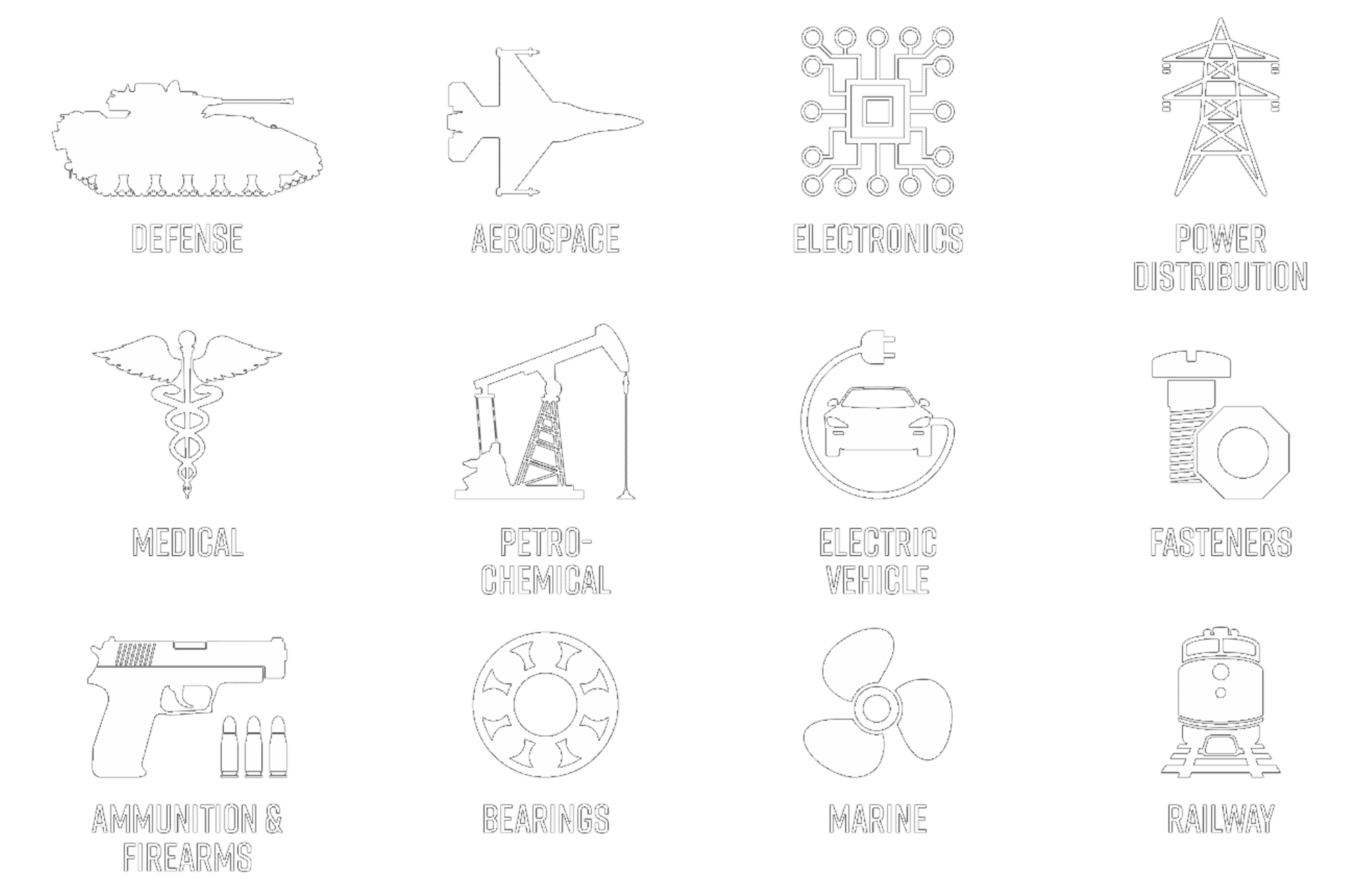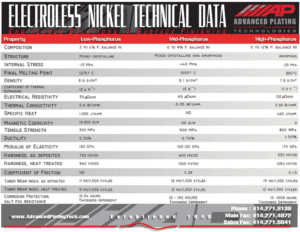Electroless nickel plating is an process that codeposits a nickel-phosphorous alloy without need for an externally applied electrical current. The 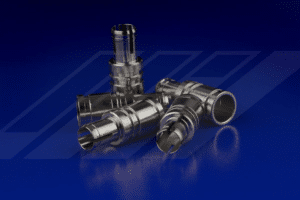
Advanced Plating Technologies, a Milwaukee, Wisconsin company, provides electroless nickel plating per MIL-C-26074, ASTM B733 and AMS 2404 as well as most company specifications. APT offers loose-piece barrel, rack and vibratory electroless nickel plating on nearly any metallic substrate including nearly any ferrous, cupreous and aluminum alloys as well as many exotic alloys. APT provides electroless nickel plating within a variety of technically-focused industries including the medical, oil & gas, power transmission/distribution and defense industries.
Electroless Nickel Plating – An Overview
Electroless nickel plating is offered by Advanced Plating Technologies in both Type IV medium phosphorous (6-9% P) and Type V high phosphorous (10-14%). The electroless nickel phosphorous content affects the properties of the deposit significantly including hardness, corrosion resistance and magnetism. Below is a brief overview of the electroless nickel plating provided by APT:
- Deposit tolerances as tight as +/- 0.0001 inches are possible
- Deposit thicknesses ranging from 0.0001 inches per side to heavy build electroless nickel plating exceeding 0.005 inches per side
- Heat treatments provided to enhance adhesion and hardness of electroless nickel deposits and can be provided without discoloration of the deposit
- APT offers a HP+™ family of high performance family of electroless nickel plating that incorporates a molecular sealer to enhance corrosion performance and dry film lubricity
- Proprietary family of black electroless nickel plating – Tacti-black® electroless nickel
- Selective electroless nickel plating with both traditional and custom-engineered selective plating techniques
- APT can combine electroless nickel plating with powder coating for electronic chassis and housing applications
- Wide range of underplates offered including copper plating or electrolytic nickel plating to provide multi-layer duplex systems to enhance corrosion performance (see: What causes metals to oxidize or “rust” within our Technical Library Plating Topics section).
Electroless Nickel Plating – What is Electroless Deposition?
Electroless nickel plating is a unique plating process that does not require an external source of electrons for deposition as in traditional electrolytic plating. Rather, electroless nickel is a nickel-phosphorous alloy deposited by a chemical reduction (reaction) from hypophosphite on a catalytic substrate without the application of external current. Since there is no applied current during deposition, electroless nickel plating deposits are free from the common nonuniformity of traditional electrolytic deposits and can cover even extremely complex geometries with excellent uniformity (see: What are the differences of electroless nickel over traditional electrolytic nickel in our Technical Library Plating Topics section).
Any portion of a part that is equally wetted by the electroless nickel solution will plate uniformly including interior or ID features. It is important to note that continual solution flow is required to maintain consistent deposition rates. As such, blind holes small inner diameters of tubing or fittings will often have reduced plating thickness. The codeposited phosphorus in the electroless nickel plating deposit increases the lubricity over that of traditional nickel plating and the percentage of phosphorus in the coating also affects deposit properties such as magnetism, corrosion resistance and hardness. In addition, a post-plate baking at temperatures above 500F can transition electroless nickel deposits from an amorphous as-plated state to a crystalline structure, greatly increasing hardness.
Electroless Nickel Plating – Deposit Properties
Reference the bullets below for the differences between medium and high phosphorus electroless nickel deposits as well as APT’s HP+™ proprietary electroless nickel plating options. Select the Electroless Nickel Technical Data PDF to the right for a comprehensive listing of physical, mechanical and electrical electroless nickel deposit properties.
- High Phosphorous Electroless Nickel Plating (> 10% P, Type V): Semi-bright appearance, non-magnetic, solderable with proper flux selection, excellent corrosion resistance, low as-plated deposit stress, excellent for heavy build, Rc 48-55 (as plated), 66-70 (with heat treatment), amorphous as-plated structure.
- Medium phosphorous Electroless Nickel Plating (6-9% P, Type IV): Semi-bright to bright appearance, magnetic, solderable with proper flux selection, good corrosion resistance, moderate as-plated deposit stress, not recommended for heavy build, Rc 58-62 (as plated), 66-70 (with heat treatment), semi-crystalline as-plated structure.
- HP+™ Electroless Nickel Plating: A proprietary process offered by APT in which a rare-earth metal molecular sealer is applied to either a high or medium phosphorous electroless nickel to enhance corrosion resistance and dry film lubricity. Contact resistance will increase some and this process is not recommended for soldering or other bonding applications. All other deposit properties remain the same per above.
Electroless Nickel Plating – Advanced Plating Technologies’ Capabilities
Specifications:
MIL-C-26074
ASTM B733
AMS 2404
ISO 4527
Most Company Specifications
Finish Type:
Medium Phosphorous Electroless Nickel
High Phosphorous Electroless Nickel
HP+™ – High Performance Electroless Nickel in High or Medium Phosphorous
Substrates Plated On:
Ferrous: All Ferrous Alloys Including Mild Steel, Stainless Steels, Hardened Steels & Tool Steels
Cuprous: All Cuprous Alloys Including Pure Copper, Copper Alloys Including Tellurium & Beryllium, Brass, Nickel-Silver
Aluminum: All Aluminum Alloys Including Wrought, Cast and Proprietary Alloys (MIC-6)
Exotics: Inconel, Pure Nickel (Nickel 200), Cobalt-Chrome (MP35N), Kovar, Monel, Hastalloy, Monel, Lead
Part Size Limitations:
32 Inches x 30 Inches x 14 Inches (Aluminum & Brass)
32 Inches x 42 Inches x 20 inches (Copper & Steel)
Underplates Provided:
Copper
Electrolytic Nickel
Heat Treatments:
Hydrogen Embrittlement Bakes
Stress Relieving Bakes
High Temperature Bakes up to 750F
Methods:
Barrel
Rack
Wire
Vibratory
Selective Loose Piece Plating
Sheet Product (Chemically Milled/Etched Sheets)
Segmented Strips (Frets)
Electroless Nickel Plating – Specifications
The two most common electroless nickel plating services certified by Advanced Plating Technologies are MIL-C-26074, ASTM B733 and AMS 2404. APT also can certify electroless nickel plating services to ISO 4527 and AMS 2405 as well as most company-specific electroless nickel specifications. A summary of electroless nickel services per the MIL, ASTM and AMS specs is as follows:
Electroless Nickel Plating to MIL-C-26074
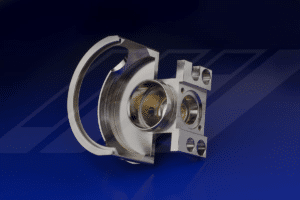
Class 2: Heat-treated to obtain required hardness. May be used on all metals not affected by heating to 500F and above. Required hardness can be obtained per the following schedule:
°F Temperature Hours
500 4 or more
550 2 or more
650 1 to 1.5
750* 0.5 to 1*
* Advanced Plating Technologies’ preferred high-hardness bake schedule is 750F for 0.5 to 1 Hour as this provides the most complete and time-consistent transition of amorphous to crystalline deposit structure to attain high hardness.
Class 3: Aluminum alloys nonheat-treatable, and beryllium alloys processed to improve adhesion of the nickel deposit. Coated nonheat-treatable aluminum parts shall be heated for 1 to 1.5 hours at 375°F +/- 15°F to improve adhesion of nickel deposit.
Class 4: Aluminum alloys, heat-treatable, processed to improve adhesion of the nickel deposit. Coated heat-treatable aluminum alloys shall be heated between 240°F to 260°F for 1 to 1.5 hours to improve adhesion of nickel deposit.
Grade A – 0.0010-inch minimum deposit thickness
Grade B – 0.0005-inch minimum deposit thickness
Grade C – 0.0015-inch minimum deposit thickness
Electroless Nickel Plating to ASTM B733-04 (and newer)
Note: ASTM B733-04 is markedly updated from ASTM B733-90 in that the coating Type specifies the phosphorous content of the coating. ASTM B733-90 does not make this distinction.
Type I: No requirement of phosphorous
Type II: 1-3% phosphorous (low phosphorous)
Type III: 2-4% phosphorous (low phosphorous)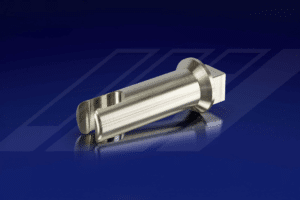
Type IV: 5-9% phosphorous (medium phosphorous)
Type V: 10% or greater phosphorous (high phosphorous)
SC0: Minimum Thickness 0.000004 in
SC1: Light Service 0.0002 in minimum
SC2: Mild Service 0.0005 in minimum
SC3: Moderate Service 0.001 in minimum
SC4: Severe Service 0.003 in minimum
NOTE 2—The performance of the autocatalytic nickel coating depends
to a large extent on the surface finish of the article to be plated and how
it was pretreated. Rough, non uniform surfaces require thicker coatings
than smooth surfaces to achieve maximum corrosion resistance and
minimum porosity.
Class 1: As-deposited, no heat treatment.
Class 2: Heat treatment at 260 to 400°C (500-752°F) to produce a minimum hardness of 850 HK100.
Class 3: Heat treatment at 180 to 200°C (356-392°F) for 2 to 4-hr to improve coating adhesion on steel and to provide for hydrogen embrittlement relief.
Class 4: Heat treatment at 120 to 130°C (248-266°F) for at least 1-hr to increase adhesion of heat-treatable (age-hardened) aluminum alloys (such as 7075) and carburized steel.
Class 5: Heat treatment at 140 to 150°C (284-302°F) for at least 1-hr to improve coating adhesion for aluminum, non age-hardened aluminum alloys, copper, copper alloys and beryllium.
Class 6: Heat treatment at 300 to 320°C (572-608°F) for at least 1-hr to improve coating adhesion for titanium alloys.
Electroless Nickel Plating to AMS 2404
Note: AMS 2404 supersedes AMS-MIL-C-26074 which employs Grade designations to convey thickness requirements. See 8.13 for a complete cross reference from AMS-MIL-C-26074 callouts to the technically identical provisions within this specification (AMS 2404) in order to comply with the purchase order requirements.
Class 1: Except for hydrogen embrittlement relief, no post plating thermal treatment.
Class 2: Thermal treatment at 450°F (232°C) or above to harden the deposit.
Class 3: Thermal treatment at 375°F (191°C) to improve adhesion for nonheat-treatable aluminum alloys and beryllium alloys.
Class 4: Thermal treatment at 250°F (121°C) to improve adhesion for heat-treatable aluminum alloys.
1.3.1 Unless a specific class is specified, Class 1 shall be supplied.
3.1.1 Stress Relief Treatment – Steel parts having a hardness of 40 HRC or higher and which have been ground after heat treatment shall be cleaned to remove surface contamination and suitable stress relieved before preparation for plating. Unless otherwise specified, the stress relief temperature shall not be less than 275°F (135°C) for not less than five hours for parts having hardness of 55 HRC or higher or not less than 375°F (191°C) for not less than four hours for other parts.
3.3.2.1 When Class 2 is specified, parts shall be heated to a selected temperature within the range of 450 to 800F and held for sufficient time to increase hardness of the deposit. See 3.4.4 and 8.6. Hydrogen embrittlement relief (3.3.1) may be omitted if Class 2 hardening is accomplished within four hours after plating.
3.3.2.2 When Class 3 is specified, parts shall be heated to 375°F +/- 15°F for 1 to 1.5 Hours.
3.3.2.3 When Class 4 is specified, parts shall be heated to 250°F +/- 10°F for 1 to 1.5 Hours.
3.4.1 Thickness
Unless otherwise specified, minimum thickness of the nickel coating shall be 0.0010 inch for aluminum based alloys, 0.0005 inch for copper, nickel, cobalt, titanium and beryllium alloys and 0.0015 inch for iron-based alloys.
3.4.4 Hardness
Class 2 plating shall be not lower than 800 HK100, or equivalent determined in accordance with ASTM E384.
3.4.7 Composition
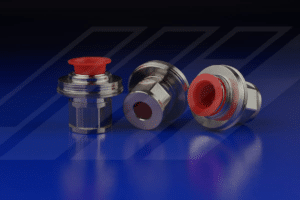
8.6 The following thermal treatments have been used to achieve Class 2 hardness:
°F Temperature Hours
450 4, minimum
500 4, minimum
550 2, minimum
650 1 to 1.5
750* 0.5 to 1*
* Advanced Plating Technologies’ preferred high-hardness bake schedule is 750F for 1 Hour minimum as this provides the most complete and time-consistent transition of amorphous to crystalline deposit structure to attain high hardness.
8.13 AMS-MIL-C-26074 and its predecessor specifications encourage the use of Grade designations to specify thickness as follows: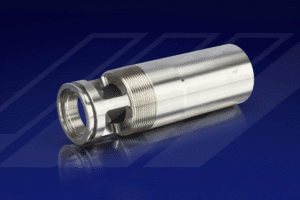
Grade A 0.0010 inch minimum
Grade B 0.0005 inch minimum
Grade C 0.0015 inch minimum

